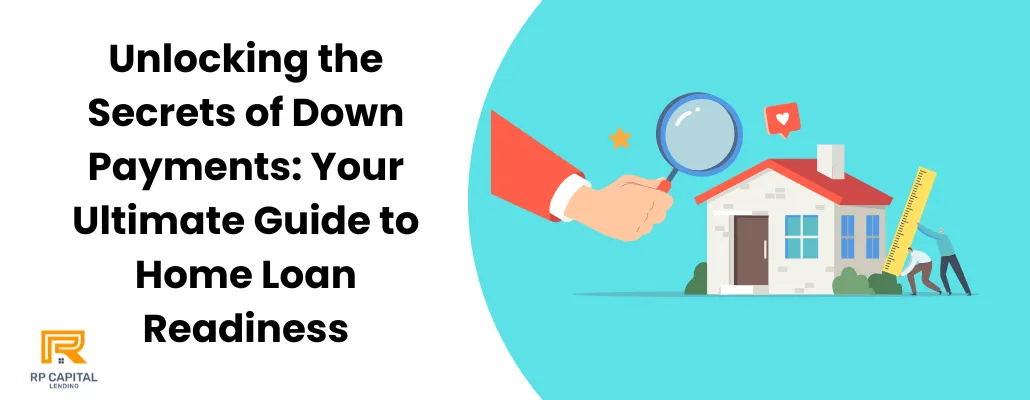Blog

Unlocking the Secrets of Down Payments: Your Ultimate Guide to Home Loan Readiness
Think securing your dream home is out of reach?
Think again!" The journey to homeownership often begins with understanding one critical component: the down payment. This upfront payment is the first step in proving to lenders that you're ready to take on the responsibility of a mortgage. But how much do you really need to save?
In this comprehensive guide, we'll unveil the secrets behind down payments, debunk common myths, and provide you with the tools you need to confidently approach your home loan application.
1. The Basics of Down Payments
At its core, a down payment is your financial stake in your future home—an upfront investment that lenders require to secure a mortgage. Traditionally, the gold standard has been to put down 20% of the home's purchase price.
This amount is not arbitrary; it strikes a balance that benefits both the lender and the borrower. For lenders, it reduces the risk of loan default. For borrowers, it can mean avoiding the additional cost of private mortgage insurance (PMI).
However, the reality is that 20% is not a one-size-fits-all solution. Various loan programs exist that allow for lower down payments, making homeownership accessible even if you can't hit that 20% mark.
2. Understanding Loan Types and Their Down Payment Requirements
The type of loan you choose has a significant impact on how much you need to save for a down payment. For example, FHA loans, backed by the Federal Housing Administration, can require as little as 3.5% down if your credit score is 580 or higher.
VA loans, available to veterans and active military members, often require no down payment at all. Conversely, conventional loans typically hover around the 20% mark but can allow for less under certain conditions.
Each loan type comes with its own set of rules, benefits, and considerations, making it crucial to research and consult with a mortgage advisor to find the best fit for your financial situation.
3. The Impact of Your Down Payment on Your Mortgage
The size of your down payment influences more than just your eligibility for a loan; it affects your mortgage's overall cost. A larger down payment reduces your loan amount, which in turn lowers your monthly mortgage payments and the amount of interest you'll pay over the life of the loan.
Additionally, surpassing the 20% threshold eliminates the need for PMI, further reducing your monthly expenses. However, it's essential to balance your down payment size with your need for liquidity. Draining your savings to make a larger down payment can leave you vulnerable to unexpected financial emergencies.
4. Saving Strategies for Your Down Payment
Saving for a down payment can seem like a daunting task, but with the right strategies, it's entirely achievable. Start by setting a clear savings goal based on your targeted home price and desired down payment percentage.
Create a budget to identify areas where you can cut expenses and increase your savings rate. Consider opening a dedicated savings account for your down payment to keep these funds separate and avoid the temptation to spend them. Additionally, explore sources of additional income, such as side gigs or selling unwanted items, to boost your savings.
5. Navigating Challenges and Solutions
Even with diligent savings, the path to accumulating a sufficient down payment can present challenges. High housing prices, student loan debt, and other financial obligations can make it difficult to save aggressively.
However, solutions exist. Look into down payment assistance programs offered by state and local governments, which can provide grants or low-interest loans to help bridge the gap.
Another option is to explore co-buying with a trusted friend or family member, allowing you to pool resources for a down payment and share the costs of homeownership.
Conclusion
The journey to homeownership is unique for everyone, and the path to securing the necessary down payment for a home loan is no exception. By understanding the basics, exploring different loan options, and implementing strategic saving plans, your dream of owning a home can become a reality. Remember, the right down payment amount for you depends on your personal financial situation, the type of loan you choose, and your long-term homeownership goals. With careful planning and a little perseverance, you'll find that the keys to your new home are well within reach.
FAQs
1: Can I buy a home with less than 20% down?
Absolutely! Many loan programs, such as FHA and VA loans, allow for down payments well below 20%. However, be prepared for the possibility of higher monthly payments and the addition of PMI if you go below this threshold.
2: Does a bigger down payment always mean a better mortgage rate?
Generally, yes. Lenders view borrowers with larger down payments as less risky, often resulting in more favorable mortgage rates. However, rates are also influenced by credit scores, income, and other factors.
3: Are there any penalties for making a smaller down payment?
The primary "penalty" for a smaller down payment is the requirement to pay PMI until you've built up sufficient equity in your home. This insurance protects the lender, not you, in case of default.
4: How can I find down payment assistance programs in my area?
A good starting point is to consult with a local housing counselor or mortgage broker. They can provide information on state and local programs for which you might qualify.
5: Is it possible to use gifted funds for a down payment?
Yes, many loan programs allow you to use gifted funds for your down payment. However, you may need to provide a letter from the donor stating that the funds are a gift and not a loan.
RP Capital Lending is a d.b.a of RP Capital Partners Inc (NMLS # 2469193) | Privacy Policy
Copyright © 2022. All Rights Reserved.
Disclaimer: Loans only apply to non-owner occupied properties. Rates, terms and conditions offered only to qualified borrowers, may vary upon loan product, deal structure, other applicable considerations, and are subject to change at any time without notice.

